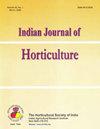Generation mean analysis of earliness and fruit yield related traits in Cucumber
Q4 Agricultural and Biological Sciences
引用次数: 0
Abstract
Gene effects associated with earliness and yield-related traits offer an advantage in the selection ofappropriate breeding strategies to bring improvement of fruit yield in Cucumber (Cucumis sativus L.). Therefore,a generation mean analysis study was conducted to investigate the gene effects present in traits like plantheight, days to first female flower, number of female flower-bearing nodes, number of lateral branches, daystook to first fruit harvest, fruit length fruit and fruit width using three cross combinations viz., Pusa Barkha ×Pusa Parthenocarpic Cucumber-6, Pusa Uday × Pusa Parthenocarpic Cucumber-6 and Punjab Naveen × PusaParthenocarpic Cucumber-6. All six generations P1, P2, F1, F2, BC1P1 and BC2P2 were developed. Scaling testresults indicated that the simple additive-dominance model is inefficient to describe gene effects in all threecrosses and interallelic interactions are present for all traits under study. Additive gene effects were significantin at least one cross out of three crosses for all traits under study except the number of lateral branches and fruitwidth. In cross Punjab Naveen × Pusa Parthenocarpic Cucumber-6, a significant negative dominant gene effectwas recorded for days to the first female flower and days took to first fruit harvest which indicates earliness inthis cross combination. For the number of female flower-bearing nodes, significant positive dominant effectswere present in cross combinations of Pusa Barkha × Pusa Parthenocarpic Cucumber-6 and Pusa Uday × PusaParthenocarpic Cucumber-6. For fruit length, Punjab Naveen × Pusa Parthenocarpic Cucumber-6 combinationpossessed significant additive gene effect which can be tapped through a simple selection procedure黄瓜早熟及果实产量相关性状的代均值分析
黄瓜早熟和产量相关性状的基因效应为选择适宜的育种策略提高黄瓜果实产量提供了有利条件。因此,采用世代均值分析研究了Pusa Barkha ×Pusa孤雌黄瓜-6、Pusa Uday ×Pusa孤雌黄瓜-6和Punjab Naveen ×Pusa孤雌黄瓜-6 3个杂交组合在株重、雌花初生天数、雌花结节数、侧枝数、果实初生天数、果长、果宽等性状上的基因效应。共发育6代P1、P2、F1、F2、BC1P1和BC2P2。标度试验结果表明,简单的加性-显性模型不能很好地描述三个杂交组合的基因效应,所有性状都存在等位基因间相互作用。除侧枝数和果宽外,3个杂交中至少有1个杂交的加性基因效应显著。在旁遮普省纳维恩×普萨孤雌黄瓜6号的杂交组合中,在第一朵雌花和第一次果实收获的几天内记录到显著的负显性基因效应,表明该杂交组合的早熟性。在雌花结节数方面,Pusa Barkha × Pusa孤雌黄瓜-6和Pusa Uday × Pusa孤雌黄瓜-6的杂交组合存在显著的正优势效应。在果实长度方面,旁遮普纳文×普萨孤雌黄瓜-6组合具有显著的加性基因效应,可通过简单的选择程序获得
本文章由计算机程序翻译,如有差异,请以英文原文为准。
求助全文
约1分钟内获得全文
求助全文
来源期刊

Indian Journal of Horticulture
农林科学-园艺
CiteScore
0.50
自引率
0.00%
发文量
22
审稿时长
4-8 weeks
期刊介绍:
Information not localized
 求助内容:
求助内容: 应助结果提醒方式:
应助结果提醒方式:


